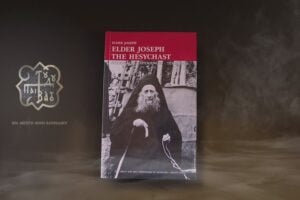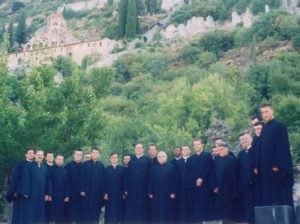Energy and personality in the theology of John Meyendorf and in contemporary philosophy (2)
17 October 2018[Previous post: http://bit.ly/2IQUhZp]
Contemporary philosophy could say perhaps that in Orthodox theology, both in Meyendorff and Palamas himself, the principle of energy did not obtain sufficiently high status and central place. After the “forgetting of energy”, as if trying to compensate for it, modern thought, starting with Heidegger, represents energy as the fundamental principle of ontology, of equal significance and status with the principle of being. According to Heidegger, in Plato being is conceived as idea, and in Aristotle it is conceived as energy; in his early Marburg lectures of 1924 he writes already: “In Aristotle’s teaching on being, energy appears as, probably, the most fundamental characteristic of being”[7]. However, in Orthodox energetism the situation is a bit different. Introducing the principle of energy actively in both Triadology and Christology and, in philosophical aspect, in ontology, it does not give the primary role to it in any of these spheres. Energy enters the triad of divine principles, Hypostasis – Ousia (or Nature) – Energeia as the last, final principle that discloses as far as it is possible ontological dynamics of divine reality ad extra, in its relation to man and world, as well as ad intra, in its Trinitarian life.
At the same time philosophical outlook should notice that Orhodox energetism brings forth new elements and connotations into our understanding of energy. The most important of these connotations relate energy to the principle of love and to the paradigm of perichoresis. As Meyendorff writes, “Through the “energy”… the divine hypostases appear in their co-inherence (perichoresis): “I am in the Father and the Father in me” (Jn 14:11) … The perichoresis expresses the perfect love, and, therefore, the perfect unity of “energy” of the three hypostases…The “energy”, because it is always Trinitarian, is always an expression and a communication of love”[8]. Interpreting Palamas’ words about the love between the hypostases in God (“150 Chapters”, Ch. 36), Fr. John concludes: “Love unites the three divine hypostases, and pours out, through their common divine “energy” or “action”, upon those worthy to receive it”[9]. But these and others conceptual connections should be considered just as particular details with respect to the key factor already stressed by us: the specific distinction of Orthodox energetism is, in the first place, its connection with personality and its integration into the personalistic description of both divine and created reality. By Orthodox teaching, energies implement the economy of personal being and bear an imprint of personality. “The Aristotelian dyad, nature-energy, was not considered sufficient in itself when applied to God, because in God’s nature, the decisive acting factor is hypostatic; hence, divine “energy” is not only unique but tri-hypostatic, since the “energy” reflects the common life of the three Persons. The personal aspects of the divine subsistence do not disappear in the one “energy””[10]. Actions of divine energies in man and world are also of profoundly personal character. Meyendorff stressed many times the importance of the Orthodox principle of the direct personal communion with God: “In Christ man meets God “face to face”… This God-giving-Himself is the divine “energy”; a living and personal God is indeed an acting God”[11]. Being involved into this personal communion with God, created human energies also acquire the impress of personality, and integration into the economy of personal being.

As we can see already, these features of Orthodox energetism distinguish it from the original Aristotelian conception of energy as well as from all modern conceptions that intend to preserve and develop the ancient Greek vision of energy. Comparative analysis of the Orthodox-palamitic understanding of energy and the ancient Greek one is a big and complicated problem. We cannot treat it in depth here, and instead of it we discuss just one significant distinction, which is, in its turn, the source of other less essential ones. In Palamas’ and then similarly in Meyendorff’s works energy is characterized as a dynamic principle, in the first place; Meyendorff insists always that the theology of energies has been created in order to make explicit the “dynamic understanding of God”, “world’s own created dynamism”, the “understanding of man as aimed dynamically to further progress in God” and so on and so forth. However, “dynamic” means related to dynamis, that is possibility, capability, force, motion, while Aristotelian energy includes important aspects making it close not to dynamis, but to entelecheia, that is complete realization, perfect accomplishment and fullness; and quite often, in many contexts energy and entelecheia are identified. Already in the beginning of the Book IX of his “Metaphysics”, where energy is treated, Aristotle says “Possibility and actuality (dynamis and energeia) embrace not only what is in motion” (1046 a2; we see here that possibility is also not restricted to the area of motion). The aspects of energy, which are not connected with the motion and change, take an important part in Aristotelian ontology; in particular, they provide the basis for the conception of the immobile Prime Mover (to proton kinoyn), one of the cornerstones of this ontology (surely, the Prime Mover possesses energy, however, it is not the energy of dynamics and motion, but the energy of perfect fullness and rest). Thus an not unimportant question comes up: are such aspects of energy represented in Orthodox energetism, the aspects, in which energy, were it divine or created, is not connected with any dynamics, motions and changes?
The answer is not evident and needs careful study. As a preliminary remark, we only notice that such study may produce different answers depending on the ontological situation: namely, in the cases when energy is acting, respectively, in divine or created being. By definition, divine being should be devoid of all motions and changes; and so energy in divine reality should represent the perfect fulfillment and completeness, i.e. it should be exactly “energy of the rest”. It was quite usual for Church Fathers to apply the concept of the Prime Mover to God[12]; but here our discussion must be a bit more precise. Divine being is Trinitarian being provided with the relations of the generation (of the Son by the Father) and the procession (of the Holy Spirit from the Father through the Son); and the three divine Hypostases are also interrelated by the perichoresis realized exactly by means of divine energy. These relations are often and with sufficient grounds characterized as ontological (not temporal) dynamics; and taking all this into account, we must say that divine reality can only be conceived antinomically as “moving rest” and “resting motion”. As for energy in the intra-Trinitarian economy, it can be interpreted as the “energy of the moving rest”, a sui generis antinomical generalization of the Aristotelian energy of the rest.
[7] M.Heidegger. Grundbegriffe der aristotelischen Philosophie. Gesamtausgabe, Band 18. Fr. a. M. 2002. S.44.
[8] John Meyendorff. Byzantine theology. P.186. (Author’s italics.)
[9] Ib.
[10] Ib. P.185-186.
[11] Ib. P.187.
[12] Cf., e.g. in Nemesius of Emesa: “There is an action that takes place in immobility as well, and God is the first who acts in this way since the Prime Mover is immobile”. On Human Nature. Moscow, 1996. P.120 (In Russian). Similarly, in Maximus the Confessor: “God… is completely immobile by His essence and nature… and moves all existing things”. The Ambigua to John, LXXX (XVIII). Moscow, 2006.P.234 (In Russian).
In the sphere of created being we find, however, a different situation. In its actions in the world divine energy is directly connected with openly dynamical manifestations: it performs ontological changes in man, his actual ascent to theosis. Here it does certainly not represent the accomplished fullness and complete actualization, it is not the energy of the rest, and all the radical “dynamism” in the Orthodox theology of energies refers exclusively to this sphere. One can agree that in this sphere, in the teaching about communion with God and the deification of man, which is directly rooted in the experience of hesychast practice, Orthodox energetism is indeed different from the energetism of Greek philosophy. But it is easy to see that such difference in the character of energy is implied with necessity by the difference between Christian and ancient Greek ontology. Due to the ontological split between divine and created being, created fallen being is not self-sufficing and complete in itself and it obtains its ontological fulfillment and completeness only in dynamics, in the “going-out of itself”. And since it has no accomplished fullness of being in itself, it has also no energy corresponding to this fullness, i.e. energy of the rest. On the contrary, for ancient Greek mind, being is just unique and perfectly accomplished throughout, and in such being energy of dynamics and motion is necessarily preceded by energy of the rest, and has its foundation in this energy. Here the discourse of equilibrium/disequilibrium is pertinent: while Greek Universe was conceived as a global reality that is in perpetual equilibrium, in Christianity created Universe is conceived as a kind of reality that is rather in global disequilibrium. The element of disequilibrium is introduced already with the act of Creation; then it is enhanced by the Fall, and is definitely consolidated by ontological drama initiated by the Incarnation. Evidently, conception of energy corresponding to global disequilibrium reality cannot be based on the primacy of energy of the rest. Greek thought kept always strong influence in the teaching on the world and due to this the intuition of global disequilibrium reality remained poorly articulated. But it was present implicitly in many subjects, and one can say, perhaps, that Palamas’ theology of energy is one of its main intrusions into the theological and philosophical discourse of Orthodoxy.
All this makes it clear that modern philosophizing when it intends to stay fully on the ground of the Aristotelian conception of energy comes to divergence with the palamitic teaching on energy. We see a striking example of such divergence in the work of Vladimir Bibikhin (1938-2004), the most significant Russian philosopher of the end of the 20th c., who was also the translator of Palamas’ “Triads” into Russian. In his large lecture course “Energy” Bibikhin presents a detailed analysis of the conceptions of energy of both Aristotle and Palamas, but also of a wide circle of related problems, including even the semantics of divine names in the Vedic poetry. He adheres firmly to the Aristotelian concept, and stresses especially the primary role of energy of the rest in this concept: “Aristotelian energy … is more primary than motion and change… It is the Prime Mover…
The Prime Mover is the fullness of energy, but it is immobile. Any force and potency is after it. It is the rest, the energy of the rest”[13]. According to Bibikhin, “For Aristotle, energy is exactly the goal, and not the means … it is the final goal, actualized being, which is full in itself, full with itself, and it is itself the goal for itself”[14]. On the other side, in the Orthodox teaching, according to Meyendorff, in the economy of the God – man relation, “the divine energy … was that which made it possible to see God and to share in the divine nature”[15]; and here as well as in other “dynamical” formulas, energy is evidently not “being which is full in itself and is itself the goal for itself” (although God is wholly present in each of His energies, He is not energy, but the “triangle” Hypostases – Ousia – Energeia). In the most evident way, this economy is realized not in the element of self-sufficing achieved and resting completeness, but in the element of reciprocal openness and self-giving of God and man when energy is “communication of love” (Meyendorff). As a result of his study, Bibikhin comes to the sharp and categorical rejection of the palamitic distinction between energy and essence. Here are some of his conclusions: “With the separation of Divine essence from His energy, energy of the rest was forgotten, it was forgotten what it is, energy of the rest… Energies in God cannot be different from essence… The distinction between essence and energy in God… is unfounded, and, what is the main thing, it is not needed… The distinction between essence and energy in God … is a fiasco of palamitic thought… The palamitic dogma is a dogmatic failure”[16].
Our discussion above clarifies the logics that can lead to such conclusions. Bibikhin notices shrewdly the key point that was not accentuated enough in the discussions of theology of energy: if we accept that this theology must preserve fully the Aristotelian primacy of energy of the rest (i.e. energy should be nothing but the “final goal, actualized being, which is full in itself, full with itself, and it is itself the goal for itself”), then palamitic statements on the partakable energy and unpartakable essence, and on the distinction of essence and energy in God are groundless. Indeed, in this case the partaking in energy is the partaking in actualized being and the perfect fullness of being, and there is nothing that could be above or beyond the limits of such partaking so that the latter should coincide with the partaking in essence. But the main thing is that here the point of divergence of Aristotelian energetism and Orthodox one is located. The latter does not reject the conception of energy of the rest, but it restricts the primacy of this energy in the sphere of created being and Divino-human economy. In the prism of history of thought, which puts aside the hesychast experiential sources of Orthodox energetism, it is difficult to admit the very possibility of such divergence. In this prism, the Greek conception is easily seen as the only possible one, and scholars in history of thought choose often antipalamitic positions till nowadays. Philosophical analysis of palamitic non-Aristotelian energetism remains an open problem, to which different approaches are thinkable. A priori, it is possible that principles of such energetism can be formulated without the radical rejection of the Aristotelian basis: e.g., by means of the extension of the latter increasing the difference between energeia and entelecheia[17] (in Bibikhin these notions are practically identified with each other).






